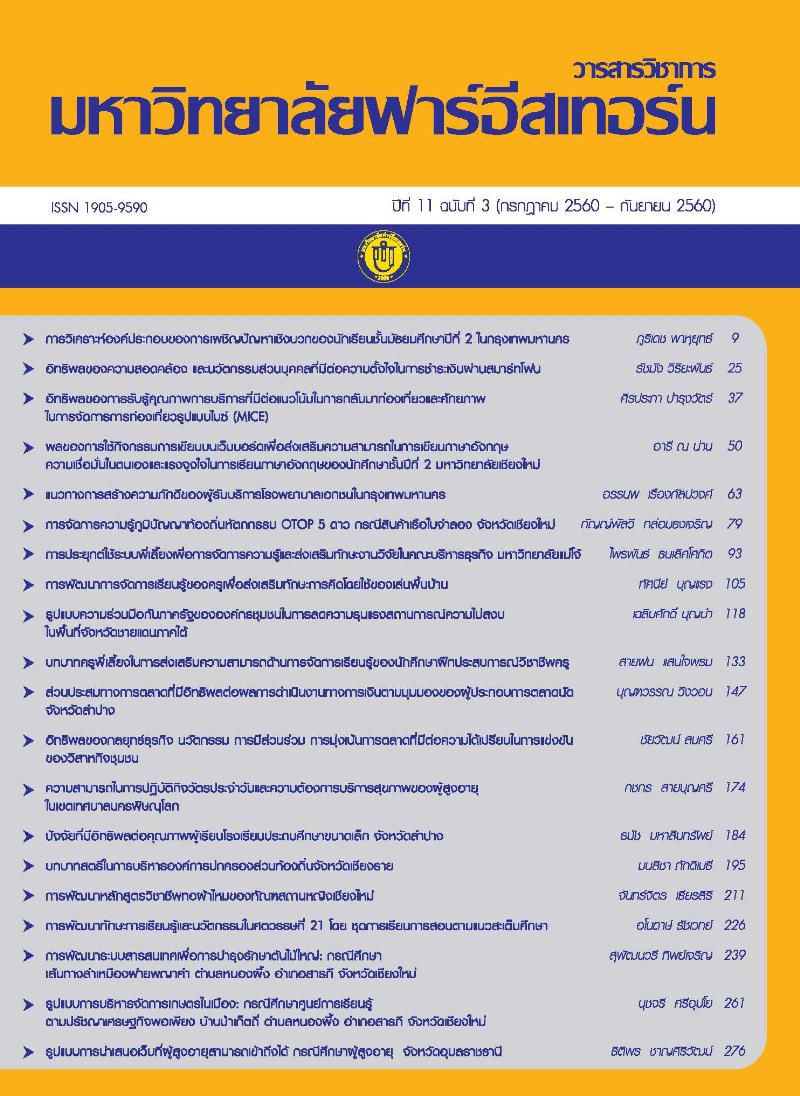อิทธิพลของความสอดคล้อง และนวัตกรรมส่วนบุคคลที่มีต่อความตั้งใจในการชำระเงินผ่านสมาร์ทโฟน
Main Article Content
Abstract
การวิจัยครั้งนี้เป็นการศึกษาอิทธิพลของความสอดคล้องและนวัตกรรมส่วนบุคคลที่มีต่อความตั้งใจ
ในการชำระเงินผ่านสมาร์ทโฟน กลุ่มตัวอย่าง คือ ผู้ที่ไม่เคยชำระเงินผ่านสมาร์ทโฟน จำนวน 446 คน
สถิติที่ใช้ในการวิเคราะห์ข้อมูล ได้แก่ ร้อยละ ความถี่ ค่าเฉล่ยี ส่วนเบี่ยงเบนมาตรฐาน การหาค่าสัมประสิทธิ์
สหสัมพันธ์เพียร์สันและการวิเคราะห์การถดถอยเชิงพหุ
ผลการวิจัยพบว่า ความสอดคล้องและนวัตกรรมส่วนบุคคล มีผลต่อความตั้งใจในการชำระเงิน
ผ่านสมาร์ทโฟนอย่างมีนัยสำคัญทางสถิติที่ระดับ 0.01 และสามารถอธิบายการเปลี่ยนแปลงของความตั้งใจ
ในการชำระเงินผ่านสมาร์ทโฟนได้ร้อยละ 40.6
This research aimed to study compatibility, and personal innovation that influenced
smartphone payment intentions. The participants were 446 respondents who previously had not
made payments by smartphones. Data were analyzed by the use of percentages, frequencies,
means, standard deviations, Pearson’s correlation and multiple regression analysis.
Findings revealed that compatibility, and personal innovation significantly influenced smartphone
payment intentions at p< 0.01. This may have explained the 40.6% change of smartphone payment
intentions.
Article Details
1. Any views and comments in the Journal of Social Innovation and Lifelong Learning are the authors’ views. The editorial staff have not to agree with those views and it is not considered as the editorial’s responsibility.
2. The responsibility of content and draft check of each article belongs to each author. In case, there is any lawsuit about copyright infringement. It is considered as the authors’ sole responsibility.
3. The article copyright belonging to the authors and The Far Eastern University are copyrighted legally. Republication must be received direct permission from the authors and The Far Eastern University in written form.
References
กระทรวงการคลัง. (2559). National e-Payment ผลิกโฉมระบบการชำระเงินของไทย (ว่องไว มั่นใจ ใช่เลย). สืบค้นเมื่อ 15 กันยายน, 2559, จาก http://goo.gl/nCqPJP
ธนาคารแห่งประเทศไทย. (2556 (ก)). ก้าวทันระบบการชำระเงินทางอิเล็กทรอนิกส์. สืบค้นเมื่อ 15 กันยายน, 2559 จาก https://goo.gl/5Mrg8X
________. (2559 (ข)). ปริมาณการชำระเงินผ่านระบบการชำระเงินและช่องทางต่าง ๆ. สืบค้นเมื่อ 15 กันยายน, 2559 จาก https://goo.gl/bKc6Wm
นิธินาถ วงศ์สวัสดิ์. (2557). ความตั้งใจของผู้ซื้อขายหลักทรัพย์ผ่านอินเทอร์เน็ต. วารสารสมาคมนักวิจัย. 19(2), 56-67.
บุญธรรม กิจปรีดาบริสุทธิ์. (2551). ระเบียบวิธีการวิจัยทางสังคมศาสตร์. กรุงเทพมหานคร: จามจุรีโปรดักท์.
ปวีณา คำพุกะ. (2557). วิจัยธุรกิจ. อุบลราชธานี: โรงพิมพ์มหาวิทยาลัยอุบลราชธานี.
ปิยะดา ทองมาก. (2558). อิทธิพลของความไว้วางใจและการรับรู้ ที่มีต่อความตั้งใจในการชำระเงินผ่านอินเทอร์เน็ต. วารสารสุทธิปริทัศน์. 29(91), 193-208.
Ahmad, I. (2015) The Generational Content Gap: How Different Generations Consume Content Online. Retrieved 15 September 2016, From www.socialmediatoday.com
Dahlberg, T., and Öörni, A. (2007). Understanding Changes in Consumer Payment Habits - Do Mobile Payments and Electronic Invoices Attract Consumers?. 40th Hawaii International Conference on System Sciences.
Lu, Y., Yang, S., Chau, P. Y., and Cao, Y. (2011) “Dynamics between the trust transfer process and intention to use mobile payment services: a cross environment perspective.” Information & Management. 48(8): 393-403.
Pham, T.-T. T., and Ho, J. C. (2015). The effects of product-related, personal-related factors and attractiveness of alternatives on consumer adoption. Technology in Society. 43, 159-172.
Rakhi, T., and Mala, S. (2014). Adoption readiness, personal innovativeness, perceived risk and usage intention across customer groups for mobile payment services in India. Internet Research. 24(3), 369-392.
Ramos-de-Luna, I., Montoro-Rı´os, F., and Lie´bana-Cabanillas, F. (2015). Determinants of the intention to use NFC technology as a payment system: an acceptance model approach. Inf Syst E-Bus Manage.14(2), 293-314.
Rogers, E. M. (1983). Diffusion of Innovations. 3rd ed. New York: The Free Press of Glence.
Rogers, E. M., and Shoemaker, F. (1978). Communication of innovations: A cross-cultural approach. New York: Free Press.
Slade, E., Dwivedi, Y., Piercy, N., and Williams, M. (2015). Modeling Consumers Adoption Intentions of Remote Mobile Payments in the United Kingdom: Extending UTAUT with Innovativeness, Risk, and Trust. Psychology & Marketing. 32(8), 860-873.
Tan, G., Ooi, K., Chong, S., and Hew, T. (2014). NFC mobile credit card: The next frontier of mobile payment?. Telematics and Informatics. 31(2), 292–307.

